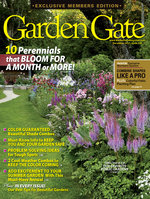
Design a garden to please the senses
Imagine walking through a well-designed sensory garden where every turn offers a new experience— whether it’s the soothing sound of rustling grasses, the vibrant colors of blooming flowers, the soft touch of velvety leaves, the intoxicating scent of a rose or the taste of fresh fruits and vegetables straight from the garden.
Whether you’re starting from scratch or enhancing an existing space, there are plenty of ways to heighten the sensory experience of your garden. Let’s explore a few of them.
You Might Also Like:
Design a Beautiful Rose Garden
Long-Blooming Perennials
Cottage Garden Collection
Designing for the sense of sight
Think about the first thing you see when you enter a garden. Is it the colorful blooms that immediately catch your eyes? Maybe it’s a striking focal point, like the bright red arbor in the photo above, or perhaps it’s the carefully designed paths and borders that guide your gaze. But ever notice how the longer you’re in a garden, the more you see? A well-designed sensory garden reveals layers of interest as you move through it.

Create balance with color
A color palette can inspire feelings of happiness and tranquility or make a bold, dramatic statement. If you want a unified, polished look, try sticking to a cohesive theme that reflects the mood you wish to create. You might opt for bright oranges and reds that energize, soft blues and purples that calm or vibrant yellows that uplift the spirit. In the photo above, the front entry bed beautifully sets the stage for the rest of the garden. The lime-green foliage and white flowers near the front of the border come forward and draw the eye to the inviting front porch while the deep green boxwoods (Buxus spp. and hybrids) recede into the background. Although shape is a more subtle visual cue than color, the repeated forms of the round boxwoods and mounded barberry (Berberis thunbergii) help create a unified look throughout the border.
As you plan your sensory garden, don’t forget to incorporate plants that offer seasonal interest. Bulbs that burst into bloom in spring, annuals that provide summer color and perennials that continue to shine well into fall will ensure your space remains vibrant throughout the year.
Add a focal point in the garden
The striking panicle hydrangea standard (Hydrangea paniculata) above helps anchor the border and provides a visual transition between the lower plants in the bed and taller trees in the backyard. If you’re looking to create a similar effect, position a striking specimen plant or feature at a key spot, such as the end of a path or near a seating area.

Designing a garden for the sense of touch
The sense of touch is often overlooked in gardens, but it can be one of the most rewarding ways to connect with your surroundings. Incorporating a variety of textures and creating designated
tactile areas invites interaction. By placing plants within easy reach along pathways, in containers on a patio or seating areas, you naturally encourage visitors to engage with the garden.
Play with textures in a sensory garden
Mix and match plants with varied leaf textures. In the photo above, the smooth, blue-green leaves of hostas (Hosta spp. and hybrids) contrast beautifully with the feathery fronds of ferns. The cascading habit and finely cut foliage of a Japanese maple (Acer palmatum) practically beg to be touched as you stroll along the stone path. Ground covers soften the edges of pathways and create a tactile experience underfoot. Trees planted close to the path invite you to brush your hand against their rough or smooth bark, offering another layer of sensory discovery. The exfoliating bark of oakleaf hydrangeas (Hydrangea quercifolia) offers fascinating color and texture, especially in winter.
Design a tactile zone
Creating a designated area for tactile exploration adds a playful element to your sensory garden, especially for children. A sandbox filled with pebbles, wood chips or sand encourages kids to dig, touch and explore. Let them feel the sand run through their fingers, squish mud between their toes and tickle a friend with a fluffy celosia plume.
Add these plants that are fun to touch
Choose varieties with fuzzy leaves and soft surfaces for a unique tactile experience.
-
Celosia (Celosia argentea cristata)
Annual; velvety and plush or papery depending on the variety, these fluffy flower heads bloom in shades of orange, red, purple, yellow and cream from summer until frost; 6 to 36 in. tall, 8 to 24 in. wide -
Lamb’s ear (Stachys byzantina)
Perennial; extremely soft, silver-gray leaves have a velvety texture and stay evergreen in warmer climates; purple flowers in early summer; 9 to 18 in. tall, 12 to 18 in. wide; cold hardy in USDA zones 4 to 8 -
Mexican bush sage (Salvia leucantha)
Tender perennial; velvety gray-green leaves and fuzzy, purple and white bicolor flowers from late summer to frost make this plant a delight to touch; 24 to 40 in. tall, 28 to 36 in. wide; cold hardy in USDA zones 8 to 10

Desiging for the sense of smell
Fragrance has the power to evoke memories, relax the mind and invigorate the spirit. Strolling along the path under the arbor in the photo below, you can relish the sweet scent of the roses (Rosa spp. and hybrids). Make the most of fragrant plants by placing them near paths or seating areas, where their scents are easily enjoyed. Position shrubs or trees near windows, allowing their fragrance to drift through, so you can appreciate the scent of your sensory garden both inside and out.
Multiseason aromas
To create a space that offers a symphony of scents, plant a mix of perennials, trees and shrubs that bloom at different times throughout the season. The delicate sweetness of lilacs in spring can give way to the heady perfume of honeysuckle (Lonicera sempervirens) in summer, followed by the rich, spicy notes of autumn sage (Salvia greggii) as the season winds down. For an evening delight, consider night-blooming flowers like common jasmine (Jasminum officinale), which releases its intoxicating scent in the cool night air.
Spice it up with edible & fragrant plants
Herbs not only add fragrance when touched, but also provide fresh flavors for your kitchen. Plant them in easily accessible spots near your patio or kitchen door so you can grab a handful whenever you need them. Ground covers, such as creeping thyme (Thymus serpyllum), release a pleasant aroma when brushed up against or stepped on.
Add fragrance to the garden with these plants
Plant these varieties to fill your sensory garden with captivating scents that create a lasting sensory experience.
-
Common lilac (Syringa vulgaris)
Shrub; white, pink or purple spring flower clusters have a sweet, floral fragrance with a hint of vanilla; 6 to 15 ft. tall, 1 to 12 ft. wide; cold hardy in USDA zones 3 to 8 -
Gardenia (Gardenia jasminoides)
Evergreen; single or double white flowers have a sweet, floral fragrance with a hint of citrus and bloom in late spring to early summer; 3 to 8 ft. tall, 3 to 6 ft. wide; cold hardy in USDA zones 7 to 11 -
‘Leonard Messel’ magnolia (Magnolia x loebneri)
Tree; white to purple-pink early spring flowers have a sweet fragrance with a hint of citrus; 10 to 20 ft. tall, 10 to 18 ft. wide; cold hardy in USDA zones 4 to 9
You Might Also Like:
Herb Planter Ideas
10 Fragrant Flowers for Your Garden
Watch Our Garden Tours on YouTube!

Designing a garden to appeal to the sense of taste
A sensory garden wouldn’t be complete without a space dedicated to culinary plants. Stepping outside and harvesting fresh fruits, vegetables and herbs at the peak of their flavor, brings a
special satisfaction. Position a small kitchen garden near your outdoor dining area, making it easy to gather fresh ingredients just steps away from your table.
Mix vegetable into garden beds
Integrating crops into the front perennial beds or borders, such as the lettuce in the photo above, ensures they are within reach for effortless harvesting. Stroll through your garden and pick ripe fruit from trees placed along pathways or near seating areas. Raspberries offer a sweet summer treat; the tasty flowers of nasturtiums (Tropaeolum majus) add a pop of color and flavor to salads, and strawberries and tomatoes are perfect for growing in containers on the patio. Trellises and vertical gardens provide space-saving solutions for climbing plants, such as pole beans (Phaseolus vulgaris) or cucumbers (Cucumis sativus), doubling as natural privacy screens that evolve with each season.
To protect your harvest from wildlife, sometimes it helps to place plants closer to the house or cover ripening fruit with netting.
Container-friendly crops
Grow these compact plants in pots on your patio for quick and convenient harvesting.
-
‘Patio Choice Yellow’ cherry tomato (Solanum lycopersicum)
Annual; round, yellow summer fruits grow on highly productive determinate plants that are great for containers; 1 to 2 ft. tall and wide -
‘Seascape’ strawberry (Fragaria x ananassa)
Perennial; highly productive, white flowers in spring and large red berries in summer, strong disease resistance; evergreen in warmer regions; 12 in. tall, 12 to 24 in. wide; cold hardy in USDA zones 4 to 9 -
‘Cherry Stuffer’ sweet pepper (Capsicum annuum)
Annual; 2-inch red summer fruits are perfect for snacking, stuffing or grilling and grow well in containers; 24 to 32 in. tall, 28 in. wide

Incorporate sound in your sensory garden
The gentle rustle of leaves, the chirping of birds and the hum of bees can turn any garden into a symphony of natural music. Consider planting grasses that sway and rustle in the breeze. Add a water feature, such as a small fountain or birdbath, for the soothing sound of flowing water. A gravel pathway like the one you see above will produce a soft crunching sound as you further explore. Wind chimes made of different materials — wood, metal or glass — can add a musical touch as they catch the wind.
Invite birds
Attract birds to your garden by adding feeders and nesting boxes. Their cheerful songs will intertwine with the rustling leaves and flowing water to create a lively soundtrack that brings your landscape to life. Draw in a variety of birds by growing plants whose berries feed them, such as viburnum (Viburnum spp. and hybrids) and downy serviceberry (Amelanchier arborea), and providing fresh seed and fruit when natural food sources are scarce.
Block out unwanted noise
Use hedges and fences to cancel out unwanted noise from nearby roads or neighbors. This not only enhances privacy but also helps maintain the peaceful atmosphere of your sensory garden. For those moments when you want to set the mood with your own music, add discreet outdoor speakers that resemble rocks to seating areas or tuck them in along a path where they can blend seamlessly with the environment.
Add plants with an element of sound
For an extra element of sound, select plants with rustling leaves and rattling seed heads.
-
Honesty (Lunaria annua)
Perennial; delicate, coinlike dried seed pods create a soft, crackling noise as they sway in the breeze; purple flowers in early to late spring; 2 to 3 ft. tall, 1 to 2 ft. wide; cold hardy in USDA zones 5 to 9 -
Love-in-a-mist (Nigella damascena)
Annual; round, horned seed capsules rattle when shaken; spidery blue, white or pink flowers in early summer; 18 to 24 in. tall, 12 to 18 in. wide -
Quaking grass (Briza media)
Grass; flat hopslike, purple maturing to tan seed heads make a soft, quaking or rattling sound in the wind; tiny green flowers in spring; 2 to 3 ft. tall, 1 to 2 ft. wide; cold hardy in USDA zones 4 to 8
















